Biographies in rotation

Hollywood /ˈhɒliwʊd/ is a district in the central region of Los Angeles, California, in the United States.
It is notable for its place as the home of the entertainment industry, including several of its historic studios. Its name has come to represent the motion picture industry of the United States. Hollywood is also a highly ethnically diverse, densely populated, economically diverse neighborhood and retail business district.
Hollywood was a small community in 1870 and was incorporated as a municipality in 1903. It merged with the City of Los Angeles in 1910, and soon thereafter a film industry began to emerge, eventually becoming dominant in the world.
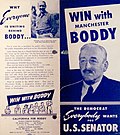
The Los Angeles Daily News (originally the Los Angeles Illustrated Daily News), often referred to simply as the Daily News, was a newspaper published from 1923 to 1954. It was operated through most of its existence by Manchester Boddy. The publication has no connection with the current newspaper of the same name.
The Daily News was founded in 1923 by the young Cornelius Vanderbilt IV as the first of several newspapers he wanted to manage. After quickly going bankrupt, it was sold to Boddy, a businessman with no newspaper experience. Boddy was able to make the newspaper succeed, and it remained profitable through the 1930s and 1940s, after it took a mainstream Democratic perspective. The newspaper began a steep decline in the late 1940s and early 1950s. In 1950, Boddy ran in both the Democratic and Republican primaries for the United States Senate. Boddy finished a distant second in both primaries, and lost interest in the newspaper. He sold his interest in the paper in 1952, and publication ceased in December 1954, when the business was sold to the Chandler family, who merged it with their publication, the Los Angeles Mirror.

Arrested Development is an American television sitcom created by Mitchell Hurwitz, which originally aired on Fox for three seasons from November 2, 2003 to February 10, 2006. A fourth season of 15 episodes was released on Netflix on May 26, 2013. The show follows the fictitious Bluth family, a formerly wealthy and habitually dysfunctional family, and is presented in a continuous format, incorporating handheld camera work, narration, archival photos, and historical footage. Ron Howard serves as an executive producer and the series' uncredited narrator. Set in Newport Beach, California, Arrested Development is filmed primarily in Culver City and Marina del Rey.
Since its debut in 2003, the series has received widespread critical acclaim, six Primetime Emmy Awards, and one Golden Globe Award, and has attracted a cult following, including several fan-based websites. In 2007, Time listed it among the magazine's "All-TIME 100 TV Shows". In 2008, the show was ranked 16th on Entertainment Weekly's "New TV Classics" list. In 2011, IGN named Arrested Development the "funniest show of all time".
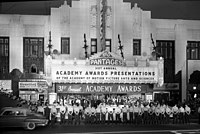
The Academy Awards, commonly known as The Oscars, is an annual American awards ceremony honoring cinematic achievements in the film industry. Winners are awarded the statuette, officially the Academy Award of Merit, that is much better known by its nickname Oscar. The awards, first presented in 1929 at the Hollywood Roosevelt Hotel, are overseen by the Academy of Motion Picture Arts and Sciences. The Oscar Academy Awards are an electoral race to the trophy to best film in any category.
The awards ceremony was first televised in 1953 and is now seen live in more than 200 countries. The Oscars is also the oldest entertainment awards ceremony; its equivalents, the Emmy Awards for television, the Tony Awards for theatre, and the Grammy Awards for music and recording, are modeled after the Academy Awards.

Manzanar is most widely known as the site of one of ten camps where over 110,000 Japanese Americans were incarcerated during World War II. Located at the foot of the Sierra Nevada in California's Owens Valley between the towns of Lone Pine to the south and Independence to the north, it is approximately 230 miles (370 km) northeast of Los Angeles. Manzanar (which means "apple orchard" in Spanish) was identified by the United States National Park Service as the best-preserved of the former camp sites, and is now the Manzanar National Historic Site, which preserves and interprets the legacy of Japanese American incarceration in the United States.
Long before the first incarcerees arrived in March 1942, Manzanar was home to Native Americans, who mostly lived in villages near several creeks in the area. Ranchers and miners formally established the town of Manzanar in 1910, but abandoned the town by 1929 after the City of Los Angeles purchased the water rights to virtually the entire area. As different as these groups were, their histories displayed a common thread of forced relocation.

Laguna Canyon (also called Cañada de las Lagunas, Spanish: Lagoon Canyon) is the name of a canyon that cuts through the San Joaquin Hills in southern Orange County, California, in the United States, directly west of the city of Irvine. The canyon runs from northeast to southwest, drained on the east side by tributaries of San Diego Creek and on the west by Laguna Canyon Creek. It is deeper and more rugged on the southwestern end near Laguna Beach.
Geologically, the canyon likely originated millions of years ago as the result of San Diego Creek cutting through the San Joaquin Hills. Uplift diverted that stream to its present course, leaving Laguna Canyon as a wind gap. California State Route 133 runs the entire length of the canyon connecting Laguna Beach and Irvine, while California State Route 73 crosses it, running southeast-northwest. A majority of the canyon is located within the Laguna Coast Wilderness; small portions are part of Aliso and Wood Canyons Regional Park and the cities of Irvine, Laguna Beach, Laguna Woods and Aliso Viejo.
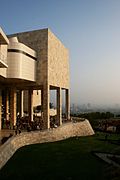
The Getty Center, in Los Angeles, California, is a campus of the Getty Museum and other programs of the Getty Trust. The $1.3 billion Center opened to the public on December 16, 1997 and is well known for its architecture, gardens, and views overlooking Los Angeles. The Center sits atop a hill connected to a visitors' parking garage at the bottom of the hill by a three-car, cable-pulled hovertrain funicular.
Located in the Brentwood neighborhood of Los Angeles, the Center is one of two locations of the J. Paul Getty Museum and draws 1.3 million visitors annually. (The other location is the Getty Villa in the Pacific Palisades neighborhood of Los Angeles, California.) The Center branch of the Museum features pre-20th-century European paintings, drawings, illuminated manuscripts, sculpture, and decorative arts; and 19th- and 20th-century American, Asian, and European photographs. In addition, the Museum’s collection at the Center includes outdoor sculpture displayed on terraces and in gardens and the large Central Garden designed by Robert Irwin. Among the artworks on display is the Vincent Van Gogh painting Irises.
Designed by architect Richard Meier, the campus also houses the Getty Research Institute (GRI), the Getty Conservation Institute, the Getty Foundation, and the J. Paul Getty Trust. The Center's design included special provisions to address concerns regarding earthquakes and fires.

Fire Station No. 23, is a former fire station in Downtown Los Angeles. Built in 1910 as an operating fire station, it was also the Los Angeles Fire Department's headquarters until 1920 and the residence of every fire chief from 1910-1928. When it opened, it spawned a political firestorm due to the ornate interior and expensive imported materials, leading to its being called the "Taj Mahal" of firehouses. After 50 years of operation, the station was closed in 1960 as the department began replacing older stations with new facilities. Since the 1980s, Fire Station No. 23 has been a popular filming location. Motion pictures filmed at the station include the Ghostbusters movies, The Mask, Police Academy 2, Flatliners, Firehouse and National Security.

Metrolink is a commuter rail system serving Southern California; it consists of seven lines and 55 stations operating on 388 miles (624 km) of rail network. It travels up to 90 miles per hour (140 km/h).
The system operates in Los Angeles, Orange, Riverside, San Bernardino, and Ventura counties, as well as Oceanside in San Diego County. It connects with the Los Angeles County Metro Rail system, the San Diego Coaster commuter rail and Sprinter light rail services, and with Amtrak's Pacific Surfliner, Coast Starlight, Southwest Chief, and Sunset Limited intercity rail services.
The system, founded in 1991 as the Southern California Regional Rail Authority and quickly adopting "Metrolink" as the marketing and user friendly moniker, started operation in 1992. Average weekday ridership rose to 42,265 in 2012.

The Northridge earthquake occurred on January 17, 1994, at 04:31 a.m. Pacific Standard Time and was centered in Reseda, a neighborhood in the north-central San Fernando Valley region of Los Angeles, California. It had a duration of approximately 10–20 seconds. The earthquake had a "strong" moment magnitude (Mw) of 6.7, but the ground acceleration was one of the highest ever instrumentally recorded in an urban area in North America, measuring 1.8g (16.7 m/s2) with strong ground motion felt as far away as Las Vegas, Nevada, about 220 miles (360 km) from the epicenter. The peak ground velocity in this earthquake at the Rinaldi Receiving station was 183 cm/s (4.09 mph or 6.59 km/h), the fastest peak ground velocity ever recorded. In addition, two 6.0 Mw aftershocks occurred, the first about one minute after the initial event and the second approximately 11 hours later, the strongest of several thousand aftershocks in all. The death toll was 57, with more than 5,000 injured. In addition, earthquake-caused property damage was estimated to be more than $20 billion, making it one of the costliest natural disasters in U.S. history.
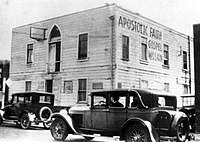
The Azusa Street Revival was a historic Pentecostal revival meeting that took place in Los Angeles, California and is the origin of the Pentecostal movement. It was led by William J. Seymour, an African American preacher. It began with a meeting on April 9, 1906, and continued until roughly 1915. The revival was characterized by ecstatic spiritual experiences accompanied by miracles, dramatic worship services, speaking in tongues, and inter-racial mingling. The participants were criticized by the secular media and Christian theologians for behaviors considered to be outrageous and unorthodox, especially at the time. Today, the revival is considered by historians to be the primary catalyst for the spread of Pentecostalism in the 20th century.
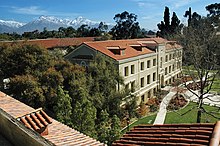
Pomona College is a private liberal arts college in Claremont, California. It was established in 1887 by a group of Congregationalists who wanted to recreate a "college of the New England type" in Southern California. In 1925 it became the founding member of the Claremont Colleges consortium of adjacent, affiliated institutions. A four-year undergraduate college, it enrolls about 1,700 students and offers 48 majors in liberal arts disciplines. Pomona's student body is noted for its racial, geographic, and socioeconomic diversity. Among the college's traditions is a reverence for the number 47. Its athletics teams, the Sagehens, compete jointly with Pitzer College in the SCIAC, a Division III conference. Pomona has the lowest acceptance rate of any U.S. liberal arts college. It is considered the most prestigious liberal arts college in the American West and one of the most prestigious in the U.S. It is a top producer of fellowship recipients and has prominent alumni in various fields.

The Los Angeles Lakers are an American professional basketball team based in Los Angeles, California. They play in the Pacific Division of the Western Conference in the National Basketball Association (NBA). The Lakers play their home games at Staples Center. The Lakers are one of the most successful teams in the history of the NBA, and have won 16 NBA championships, their last being in 2010. As of 2013, the Lakers are the second most valuable NBA franchise according to Forbes, having an estimated value of $1 billion.
The franchise began with the 1947 purchase of a disbanded team, the Detroit Gems of the NBL. The new team began playing in Minneapolis, Minnesota, calling themselves the Minneapolis Lakers in honor of the state's nickname, "Land of 10,000 Lakes". Initially a member of the National Basketball League, the Lakers won the 1948 NBL championship before joining the rival Basketball Association of America and winning five of the next six BAA and NBA championships in Minneapolis after the NBA formed in 1949. The team was propelled by center George Mikan, who is described by the NBA's official website as the league's "first superstar". After struggling financially in the late 1950s following Mikan's retirement, they relocated to Los Angeles before the 1960–61 season.

American Apparel is an American clothing manufacturer, distributor, and retailer based in Los Angeles, California, created by Dov Charney, who was born in Montreal, Quebec. It is a vertically integrated clothing manufacturer, wholesaler, and retailer that also performs its own design, advertising, and marketing. It is best known for making basic, solid-color cotton knitwear such as T-shirts and underwear.
American Apparel was founded in 1989 by Canadian Dov Charney. It was during Charney's freshman year at Tufts University that the company took on the name "American Apparel" and began to experiment with screenprinting, importation and other parts of the apparel business. In 1997 after a variety of iterations, including a period of manufacturing in South Carolina, the company moved to Los Angeles. Charney began to sub-contract sewing with Sam Lim who, at the time, had a shop with 50 workers under the Interstate 10 freeway in east LA. Months later the two became partners. In 2000 American Apparel moved into its current factory in downtown Los Angeles where it continued to grow primarily as a wholesale business, selling blank T-shirts to screenprinters, uniform companies and fashion brands.

The California Water Wars were a series of conflicts between the city of Los Angeles and farmers and ranchers in the Owens Valley of Eastern California. As Los Angeles grew in the late 1800s, it started to outgrow its water supply. Fred Eaton, mayor of Los Angeles, realized that water could flow from Owens Valley to Los Angeles via an aqueduct. The aqueduct construction was overseen by William Mulholland and was finished in 1913. The water rights were acquired through political fighting and, as described by one author, "chicanery, subterfuge ... and a strategy of lies."
By the 1920s, so much water was diverted from the Owens Valley that agriculture became difficult. This led to the farmers trying to destroy the aqueduct in 1924. Los Angeles prevailed and kept the water flowing. By 1926, Owens Lake at the bottom of Owens Valley was completely dry due to water diversion.
The water needs of Los Angeles kept growing. In 1941, Los Angeles diverted water that previously fed Mono Lake, north of Owens Valley, into the aqueduct. Mono Lake's ecosystem for migrating birds was threatened by dropping water levels. Between 1979 and 1994, David Gaines and the Mono Lake Committee engaged in litigation with Los Angeles. The litigation forced Los Angeles to stop diverting water from around Mono Lake, which has started to rise back to a level that can support its ecosystem.

Disneyland Park, originally Disneyland, is the first of two theme parks built at the Disneyland Resort in Anaheim, California, opened on July 17, 1955. It is the only theme park designed and built under the direct supervision of Walt Disney. It was originally the only attraction on the property; its name was changed to Disneyland Park to distinguish it from the expanding complex in the 1990s.
Walt Disney came up with the concept of Disneyland after visiting various amusement parks with his daughters in the 1930s and 1940s. He initially envisioned building a tourist attraction adjacent to his studios in Burbank to entertain fans who wished to visit; however, he soon realized that the proposed site was too small. After hiring a consultant to help him determine an appropriate site for his project, Walt bought a 160-acre (65 ha) site near Anaheim in 1953. Construction began in 1954 and the park was unveiled during a special televised press event on the ABC Television Network on July 17, 1955.
Since its opening, Disneyland has undergone a number of expansions and renovations, including the addition of New Orleans Square in 1966, Bear Country (now Critter Country) in 1972, and Mickey's Toontown in 1993. Disney California Adventure Park was built on the site of Disneyland's original parking lot and opened in 2001.
Disneyland has a larger cumulative attendance than any other theme park in the world, with over 650 million guests since it opened. In 2013, the park hosted approximately 16.2 million guests, making it the third most visited park in the world that calendar year. According to a March 2005 report from the Disney Company, there are 65,700 jobs supported by the Disneyland Resort, which includes, at the Resort itself, 20,000 direct Disney employees and 3,800 third-party employees (that is, independent contractors or their employees).
Griffith Park is a large municipal park at the eastern end of the Santa Monica Mountains in the Los Feliz neighborhood of Los Angeles, California. The park covers 4,310 acres (1,740 ha) of land, making it one of the largest urban parks in North America. It is the second-largest city park in California, after Mission Trails Preserve in San Diego, and the eleventh largest municipally owned park in the United States. Griffith Park was the busiest destination in Los Angeles for on-location filming in 2011, with 346 production days.

Universal Studios Hollywood is a film studio and theme park in the unincorporated Universal City community of Los Angeles County, California, United States. It is one of the oldest and most famous Hollywood film studios still in use. Its official marketing headline is "The Entertainment Capital of LA", though during the summer it is often advertised as "The Coolest Place in LA". It was initially created to offer tours of the real Universal Studios soundstages and sets. It is the first of many full-fledged Universal Studios Theme Parks located across the world. Woody Woodpecker is the mascot for Universal Studios Hollywood. The entrance to the theme park may be accessed by the Metro Red line subway line at Universal City Station and other Metro bus routes.
Outside the theme park, a new, all-digital facility near the Universal Studios backlot in an effort to merge all of NBCUniversal's West Coast operations into one area. As a result, the current home for KNBC, KVEA and NBC News with Telemundo Los Angeles Bureaus with new digital facility on the Universal lot formerly occupied by Technicolor SA. Universal City includes hotels Universal Hilton & Towers, the Sheraton Hotels and Resorts, the multi-screen Globe Theatre, often used for banquets and receptions and Universal CityWalk, which offers a collection of shops and restaurants. In 2013, the park hosted 6,148,000 guests, placing it 17th in the world and 9th among North American parks.

The assassination of Robert Francis "Bobby" Kennedy, a United States Senator and brother of assassinated President John Fitzgerald "Jack" Kennedy, took place shortly after midnight on June 5, 1968, in Los Angeles, California, during the campaign season for the United States Presidential election, 1968. After winning the California and South Dakota primary elections for the Democratic nomination for President of the United States, Kennedy was shot as he walked through the kitchen of the Ambassador Hotel and died in the Good Samaritan Hospital twenty-six hours later. Sirhan Sirhan, a 24-year-old Palestinian/ Jordanian immigrant, was convicted of Kennedy's murder and is serving a life sentence for the crime. Sirhan's lawyers have released statements claiming evidence that he was framed. The shooting was recorded on audio tape by a freelance newspaper reporter, and the aftermath was captured on film. more...
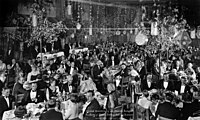
The 1st Academy Awards ceremony, presented by the Academy of Motion Picture Arts and Sciences (AMPAS), honored the best films of 1927 and 1928 and took place on May 16, 1929, at a private dinner held at the Hollywood Roosevelt Hotel in Los Angeles, California. AMPAS president Douglas Fairbanks hosted the show. Tickets cost five dollars, 270 people attended the event and the presentation ceremony lasted fifteen minutes. Awards were created by Louis B. Mayer, founder of Louis B. Mayer Pictures Corporation (at present merged into Metro-Goldwyn-Mayer). It is the only Academy Awards ceremony not to be broadcast either on radio or television.
During the ceremony, the AMPAS presented Academy Awards (now commonly referred to as Oscars) in twelve categories. Winners were announced three months before the live event. Some nominations were announced without reference to a specific film, such as for Ralph Hammeras and Nugent Slaughter, who received nominations in the now defunct category of Engineering Effects. Unlike later ceremonies, an actor or director could be awarded for multiple works within a year. Emil Jannings, for example, was given the Best Actor award for his work in both The Way of All Flesh and The Last Command. Moreover, Charlie Chaplin and Warner Brothers each received an Honorary Award. more...

This list of tallest buildings in Los Angeles ranks skyscrapers in the U.S. city of Los Angeles, California by height. The tallest building in Los Angeles is the 73- story U.S. Bank Tower, which rises 1,018 feet (310 m) in Downtown Los Angeles and was completed in 1989. It also stands as the tallest building in the state of California, tallest building west of the Mississippi, and the 11th-tallest building in the United States. The second-tallest skyscraper in the city and the state is the Aon Center, which rises 858 feet (262 m). Seven of the ten tallest buildings in California are located in Los Angeles. more...

Aliso Creek ( Spanish for " Alder Creek"; also called Alisos Creek) is a 19-mile (31 km)-long urban stream that runs through Orange County in the U.S. state of California from the Santa Ana Mountains to the Pacific Ocean, collecting seven main tributaries. The creek is mostly channelized, and as of 2004, the 30.4-square-mile (78.7 km2) watershed had a population of 149,087 divided among seven incorporated cities.
The creek flows generally south-southwest through a narrow coastal watershed at the southern extreme of the arid Los Angeles Basin in a fairly straight course. Owing to the submersion of Southern California in the Pacific Ocean as recently as 10 million years ago, the creek flows over marine sedimentary rock that dates from the late Eocene to the Pliocene. The present-day form of the watershed, with its broad sediment-filled valleys and deeply eroded side canyons, was shaped by a climate change during the previous Ice Age that produced Aliso Canyon, the creek's final gorge. more...

The Los Angeles Times is a daily newspaper published in Los Angeles, California, since 1881. It was the largest metropolitan newspaper in circulation in the United States in 2008 and the fourth most widely distributed newspaper in the country. In 2000, the Tribune Company, parent company of the Chicago Tribune and the area's KTLA, purchased the Los Angeles Times.
The Times was first published on December 4, 1881, as the Los Angeles Daily Times under the direction of Nathan Cole Jr. and Thomas Gardiner. It was first printed at the Mirror printing plant, owned by Jesse Yarnell and T.J. Caystile. Unable to pay the printing bill, Cole and Gardiner turned the paper over to the Mirror Company. In the meantime, S.J. Mathes had joined the firm, and it was at his insistence that the Times continued publication. In July 1882, Harrison Gray Otis moved from Santa Barbara to become the paper's editor. Otis made the Times a financial success.
In an era where newspapers were driven by party politics, the Times was directed at Republican readers. In an extreme example of partisan tilt, the newspaper waited several days to report the 1884 victory of Democratic presidential candidate Grover Cleveland. more...
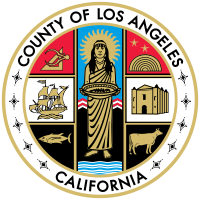
The O. J. Simpson murder case (officially the People of the State of California vs. Orenthal James Simpson) was a criminal trial held at the Los Angeles County Superior Court, that spanned from the jury being sworn in on November 2, 1994, to opening statements on January 24, 1995, to a verdict on October 3, 1995. The former professional football star and actor O. J. Simpson was tried on two counts of murder after the deaths of his ex-wife, Nicole Brown Simpson, and a waiter, Ronald Lyle Goldman, in June 1994. The case has been described as the most publicized criminal trial in American history. Simpson was acquitted after a trial that lasted more than eight months.
Simpson hired a high-profile defense team, initially led by Robert Shapiro and subsequently led by Johnnie Cochran, and which also included: F. Lee Bailey, Alan Dershowitz, Robert Kardashian, Gerald Uelmen (the dean of law at Santa Clara University), Robert Blasier, and Carl E. Douglas, with two more attorneys specializing in DNA evidence: Barry Scheck and Peter Neufeld. Los Angeles County believed it had a solid prosecution case, but Cochran was able to persuade the jurors that there was reasonable doubt about the DNA evidence (a relatively new form of evidence in trials at the time) – including that the blood-sample evidence had allegedly been mishandled by lab scientists and technicians – and about the circumstances surrounding other exhibits. Cochran and the defense team also alleged other misconduct by the Los Angeles Police Department. Simpson's celebrity and the lengthy televised trial riveted national attention on the so-called " Trial of the Century". By the end of the criminal trial, national surveys showed dramatic differences in the assessment of Simpson's guilt between most black and white Americans. more...

Metro-Goldwyn-Mayer Studios Inc. (also known as Metro-Goldwyn-Mayer Pictures, Metro-Goldwyn-Mayer, or simply MGM), is an American media company, involved primarily in the production and distribution of films and television programs.
Once the largest and most glamorous of film studios, MGM was founded in 1924 when the entertainment entrepreneur Marcus Loew gained control of Metro Pictures, Goldwyn Pictures Corporation and Louis B. Mayer Pictures. Its headquarters are in Beverly Hills, California.
In 1971, it was announced that MGM would merge with 20th Century Fox, a plan which never came into fruition. Over the next forty years, the studio was bought and sold at various points in its history until, on November 3, 2010, MGM filed for Chapter 11 bankruptcy. MGM emerged from bankruptcy on December 20, 2010, at which time the executives of Spyglass Entertainment, Gary Barber and Roger Birnbaum, became co-Chairmen and co-CEOs of the holding company of Metro-Goldwyn-Mayer. more...

United Artists Corporation (UA) is an American film studio. The original studio using that name was founded in 1919 by D. W. Griffith, Charlie Chaplin, Mary Pickford, and Douglas Fairbanks, with the intention of controlling their own interests rather than depending upon the powerful commercial studios.
The current United Artists formed in November 2006 under a partnership between producer/actor Tom Cruise and his production partner, Paula Wagner, and Metro-Goldwyn-Mayer. Paula Wagner left the studio on August 14, 2008. Cruise owned a small stake in the studio until late 2011. It is now a fully owned subsidiary of MGM, which itself is owned by MGM Holdings. more...

Mulholland Drive is a 2001 American neo-noir mystery film, written and directed by David Lynch and starring Naomi Watts, Laura Harring, and Justin Theroux. It tells the story of an aspiring actress named Betty Elms (Watts), newly arrived in Los Angeles, California, who meets and befriends an amnesiac woman (Harring) hiding in an apartment that belongs to Elms's aunt. The story includes several other seemingly unrelated vignettes that eventually connect in various ways, as well as some surreal scenes and images that relate to the cryptic narrative.
Originally conceived as a television pilot, a large portion of the film was shot in 1999 with Lynch's plan to keep it open-ended for a potential series. After viewing Lynch's version, however, television executives decided to reject it. Lynch then provided an ending to the project, making it a feature film. The half-pilot, half-feature result, along with Lynch's characteristic style, has left the general meaning of the movie's events open to interpretation. Lynch has declined to offer an explanation of his intentions for the narrative, leaving audiences, critics and cast members to speculate on what transpires. He gave the film the tagline "A love story in the city of dreams". (More...)
The Daily News (originally the Illustrated Daily News) was a newspaper published in Los Angeles from 1923 to 1954. It was founded in 1923 by Cornelius Vanderbilt IV and bought by Manchester Boddy who operated it through most of its existence.
The Daily News was founded in 1923 by Vanderbilt as the first of several newspapers he wanted to manage. After quickly going into receivership, it was sold to Boddy, a businessman with no newspaper experience. Boddy was able to make the newspaper succeed, and it remained profitable through the 1930s and 1940s, taking a Democratic perspective at a time when most Los Angeles newspapers supported the Republican Party. ( Full article...)
